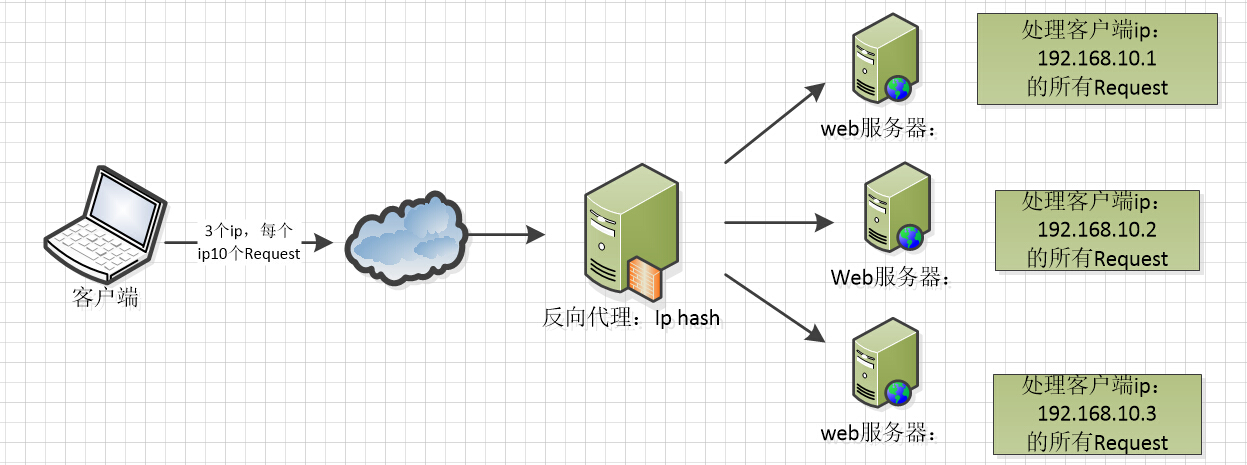Nginx配置詳解
最近在搞nginx和tomcat 以及apache的集群。下面是參考的一片很不錯的關於nginx配置的詳細講解:
http://www.cnblogs.com/knowledgesea/p/5175711.html
序言
Nginx是lgor Sysoev為俄羅斯訪問量第二的rambler.ru站點設計開發的。從2004年發布至今,憑借開源的力量,已經接近成熟與完善。
Nginx功能豐富,可作為HTTP服務器,也可作為反向代理服務器,郵件服務器。支持FastCGI、SSL、Virtual Host、URL Rewrite、Gzip等功能。並且支持很多第三方的模塊擴展。
Nginx的穩定性、功能集、示例配置文件和低系統資源的消耗讓他後來居上,在全球活躍的網站中有12.18%的使用比率,大約為2220萬個網站。
牛逼吹的差不多啦,如果你還不過癮,你可以百度百科或者一些書上找到這樣的誇耀,比比皆是。
Nginx常用功能
1、Http代理,反向代理:作為web服務器最常用的功能之一,尤其是反向代理。
這裏我給來2張圖,對正向代理與反響代理做個詮釋,具體細節,大家可以翻閱下資料。

Nginx在做反向代理時,提供性能穩定,並且能夠提供配置靈活的轉發功能。Nginx可以根據不同的正則匹配,采取不同的轉發策略,比如圖片文件結尾的走文件服務器,動態頁面走web服務器,只要你正則寫的沒問題,又有相對應的服務器解決方案,你就可以隨心所欲的玩。並且Nginx對返回結果進行錯誤頁跳轉,異常判斷等。如果被分發的服務器存在異常,他可以將請求重新轉發給另外一臺服務器,然後自動去除異常服務器。
2、負載均衡
Nginx提供的負載均衡策略有2種:內置策略和擴展策略。內置策略為輪詢,加權輪詢,Ip hash。擴展策略,就天馬行空,只有你想不到的沒有他做不到的啦,你可以參照所有的負載均衡算法,給他一一找出來做下實現。
上3個圖,理解這三種負載均衡算法的實現

Ip hash算法,對客戶端請求的ip進行hash操作,然後根據hash結果將同一個客戶端ip的請求分發給同一臺服務器進行處理,可以解決session不共享的問題。 
3、web緩存
Nginx可以對不同的文件做不同的緩存處理,配置靈活,並且支持FastCGI_Cache,主要用於對FastCGI的動態程序進行緩存。配合著第三方的ngx_cache_purge,對制定的URL緩存內容可以的進行增刪管理。
4、Nginx相關地址
源碼:https://trac.nginx.org/nginx/browser
官網:http://www.nginx.org/
Nginx配置文件結構
如果你下載好啦,你的安裝文件,不妨打開conf文件夾的nginx.conf文件,Nginx服務器的基礎配置,默認的配置也存放在此。
在nginx.conf的註釋符號位#
nginx文件的結構,這個對剛入門的同學,可以多看兩眼。
默認的config


#user nobody;
worker_processes 1;
#error_log logs/error.log;
#error_log logs/error.log notice;
#error_log logs/error.log info;
#pid logs/nginx.pid;
events {
worker_connections 1024;
}
http {
include mime.types;
default_type application/octet-stream;
#log_format main ‘$remote_addr - $remote_user [$time_local] "$request" ‘
# ‘$status $body_bytes_sent "$http_referer" ‘
# ‘"$http_user_agent" "$http_x_forwarded_for"‘;
#access_log logs/access.log main;
sendfile on;
#tcp_nopush on;
#keepalive_timeout 0;
keepalive_timeout 65;
#gzip on;
server {
listen 80;
server_name localhost;
#charset koi8-r;
#access_log logs/host.access.log main;
location / {
root html;
index index.html index.htm;
}
#error_page 404 /404.html;
# redirect server error pages to the static page /50x.html
#
error_page 500 502 503 504 /50x.html;
location = /50x.html {
root html;
}
# proxy the PHP scripts to Apache listening on 127.0.0.1:80
#
#location ~ \.php$ {
# proxy_pass http://127.0.0.1;
#}
# pass the PHP scripts to FastCGI server listening on 127.0.0.1:9000
#
#location ~ \.php$ {
# root html;
# fastcgi_pass 127.0.0.1:9000;
# fastcgi_index index.php;
# fastcgi_param SCRIPT_FILENAME /scripts$fastcgi_script_name;
# include fastcgi_params;
#}
# deny access to .htaccess files, if Apache‘s document root
# concurs with nginx‘s one
#
#location ~ /\.ht {
# deny all;
#}
}
# another virtual host using mix of IP-, name-, and port-based configuration
#
#server {
# listen 8000;
# listen somename:8080;
# server_name somename alias another.alias;
# location / {
# root html;
# index index.html index.htm;
# }
#}
# HTTPS server
#
#server {
# listen 443 ssl;
# server_name localhost;
# ssl_certificate cert.pem;
# ssl_certificate_key cert.key;
# ssl_session_cache shared:SSL:1m;
# ssl_session_timeout 5m;
# ssl_ciphers HIGH:!aNULL:!MD5;
# ssl_prefer_server_ciphers on;
# location / {
# root html;
# index index.html index.htm;
# }
#}
}

nginx文件結構

... #全局塊
events { #events塊
...
}
http #http塊
{
... #http全局塊
server #server塊
{
... #server全局塊
location [PATTERN] #location塊
{
...
}
location [PATTERN]
{
...
}
}
server
{
...
}
... #http全局塊
}

1、全局塊:配置影響nginx全局的指令。一般有運行nginx服務器的用戶組,nginx進程pid存放路徑,日誌存放路徑,配置文件引入,允許生成worker process數等。
2、events塊:配置影響nginx服務器或與用戶的網絡連接。有每個進程的最大連接數,選取哪種事件驅動模型處理連接請求,是否允許同時接受多個網路連接,開啟多個網絡連接序列化等。
3、http塊:可以嵌套多個server,配置代理,緩存,日誌定義等絕大多數功能和第三方模塊的配置。如文件引入,mime-type定義,日誌自定義,是否使用sendfile傳輸文件,連接超時時間,單連接請求數等。
4、server塊:配置虛擬主機的相關參數,一個http中可以有多個server。
5、location塊:配置請求的路由,以及各種頁面的處理情況。
下面給大家上一個配置文件,作為理解,同時也配入我搭建的一臺測試機中,給大家示例。

########### 每個指令必須有分號結束。#################
#user administrator administrators; #配置用戶或者組,默認為nobody nobody。
#worker_processes 2; #允許生成的進程數,默認為1
#pid /nginx/pid/nginx.pid; #指定nginx進程運行文件存放地址
error_log log/error.log debug; #制定日誌路徑,級別。這個設置可以放入全局塊,http塊,server塊,級別以此為:debug|info|notice|warn|error|crit|alert|emerg
events {
accept_mutex on; #設置網路連接序列化,防止驚群現象發生,默認為on
multi_accept on; #設置一個進程是否同時接受多個網絡連接,默認為off
#use epoll; #事件驅動模型,select|poll|kqueue|epoll|resig|/dev/poll|eventport
worker_connections 1024; #最大連接數,默認為512
}
http {
include mime.types; #文件擴展名與文件類型映射表
default_type application/octet-stream; #默認文件類型,默認為text/plain
#access_log off; #取消服務日誌
log_format myFormat ‘$remote_addr–$remote_user [$time_local] $request $status $body_bytes_sent $http_referer $http_user_agent $http_x_forwarded_for‘; #自定義格式
access_log log/access.log myFormat; #combined為日誌格式的默認值
sendfile on; #允許sendfile方式傳輸文件,默認為off,可以在http塊,server塊,location塊。
sendfile_max_chunk 100k; #每個進程每次調用傳輸數量不能大於設定的值,默認為0,即不設上限。
keepalive_timeout 65; #連接超時時間,默認為75s,可以在http,server,location塊。
upstream mysvr {
server 127.0.0.1:7878;
server 192.168.10.121:3333 backup; #熱備
}
error_page 404 https://www.baidu.com; #錯誤頁
server {
keepalive_requests 120; #單連接請求上限次數。
listen 4545; #監聽端口
server_name 127.0.0.1; #監聽地址
location ~*^.+$ { #請求的url過濾,正則匹配,~為區分大小寫,~*為不區分大小寫。
#root path; #根目錄
#index vv.txt; #設置默認頁
proxy_pass http://mysvr; #請求轉向mysvr 定義的服務器列表
deny 127.0.0.1; #拒絕的ip
allow 172.18.5.54; #允許的ip
}
}
}

上面是nginx的基本配置,需要註意的有以下幾點:
1、1.$remote_addr 與$http_x_forwarded_for 用以記錄客戶端的ip地址; 2.$remote_user :用來記錄客戶端用戶名稱; 3.$time_local : 用來記錄訪問時間與時區;4.$request : 用來記錄請求的url與http協議;
5.$status : 用來記錄請求狀態;成功是200, 6.$body_bytes_s ent :記錄發送給客戶端文件主體內容大小;7.$http_referer :用來記錄從那個頁面鏈接訪問過來的; 8.$http_user_agent :記錄客戶端瀏覽器的相關信息;
2、驚群現象:一個網路連接到來,多個睡眠的進程被同事叫醒,但只有一個進程能獲得鏈接,這樣會影響系統性能。
3、每個指令必須有分號結束。
Nginx配置詳解
